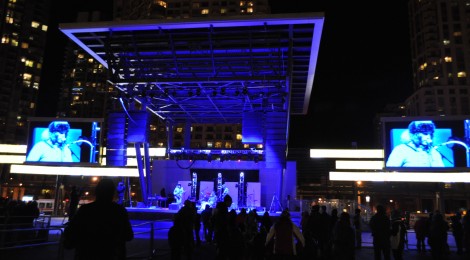
Experience it: An Analysis of the Mississauga Celebration Square
Site: Mississauga Celebration Square
Location: City Centre Dr, Mississauga, ON
(Bordered by Duke of York Blvd, Burnhamthorpe Rd W, Central Library (301 Burnhamthorpe Rd W), and City Centre Dr)
Description
The Mississauga Celebration Square is an outdoor venue located in the centre of Mississauga that provides free events and activities such as concerts, skating, holiday celebrations, movies, and more, all year round. An emphasis on multiculturalism is revealed through specific types of events such as Italfest, Muslimfest, and Viet Summerfest. The Square utilizes its amphitheatre to deliver local musical performances such as the “battle of the band”, “jam nights” and “open mic night” as well as its main stage for more popular artists. Similar to Toronto’s Nathan Phillips Square, this suburban locale allows guests to move freely in the open space. Its dependency on a sound system and television screens provides guests with both an audible and visual experience. The location of the Square along with its dense population and proximity to high-rise condominiums, theatres, and shops creates a downtown ambience which inevitably enhances the Square’s liveliness. From a soccer field in the summer to a skating rink in the winter, this large and flexible space provides Mississauga with the resources to successfully entertain a variety of demographics.
A Historical Overview of the Square
The Celebration Square is part of the city centre which is the “downtown” core of Mississauga. Therefore, in order to understand why the Square was built in this particular location, I had to research how the surrounding area was used as well. Throughout my digging, I found that Mississauga’s city centre has a relatively shorter history than Toronto. According to the Illustrated Historical Atlas of the County of Peel, the present-day city centre was part of the Township of Toronto in 1877. The atlas reveals that the city centre was a mass of farms. Using land surveys, I found that the area of Celebration Square, Square One, and surrounding buildings was owned by Charles Wilcox, a farmer who settled in 1830 (see Figure 1). Wilcox was listed under the title, “Official, Professional, Business Men and Citizens” (See Figure 2). Later on, Robert Carr gained ownership of the land and also farmed from 1913 until 1959 (Hicks, 2005), (see Figure 3 & 4).
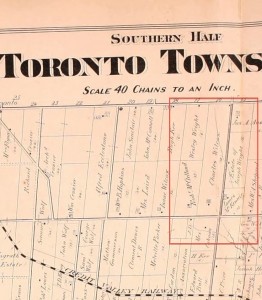
Figure 1: Charles Wilcox, a farmer, owned the land that is now home to Square One, the civic centre, and to the Celebration Square.
Source: Pope. J. H. (1877). Illustrated Historical Atlas of the County of Peel, Ont. Toronto: Walker & Miles.

Figure 2: Wilcox’s name appears under the “Official, Professional, Business Men and Citizens” list.
Source: Pope. J. H. (1877). Illustrated Historical Atlas of the County of Peel, Ont. Toronto: Walker & Miles.
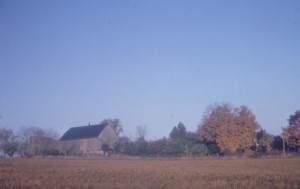
Figure 3: An old photo taken of the Carr Farm in 1963. This was before the city centre was built.
Identifier: F922. Courtesy of The City Centre Gallery, Mississauga Library System.
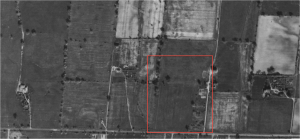
Figure 4: Aerial view of the Carr Farm in 1954, the earliest aerial photograph of this area, eMaps, Mississauga’s Interactive Online Mapping Service
Retrieved on November 27, 2013 on http://www.mississauga.ca/portal/services/maps.
S.B. McLaughlin “saw Hurontario street as a future Yonge Street and began buying farms in the 1950s” (Urbaniak, 2009, p. 65) including the Carr farm which was 100 acres of the south half of Lot 16, Con. 2, NDS (Hicks, 2005). McLaughlin’s plan was to build a large shopping mall in the area which is now Square One. According to the South Peel Weekly, a fire destroyed Mississauga’s original municipal building in Cooksville (just south of the current city centre) in June of 1969. By this time, McLaughlin and “his company’s 237-acre Mississauga City Centre was being built at Highway 10 and Burnhamthorpe” (“McLaughlin Makes”, 1969). Following the fire, McLaughlin made an offer to the Mayor Bob Speck “to relocate the civic centre at Burnhamthorpe and Highway 10” (“McLaughlin Makes”, 1969). Without this detrimental fire, it is highly unlikely that the city centre would be where it is today. In the Mississauga Times in June 1970, it was acknowledged that the civic centre was to be built by Square One shopping centre (see Figure 5 & 6), and would work to “house the governmental and administrative task force necessary to administer the needs of the community’s 135,000 residents” (“Mayor Plants”, 1970).
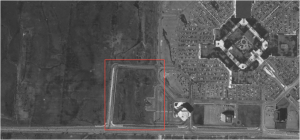
Figure 5: Square One is already built to the right, while the rest of the land to the left is still farmland. Highlighted in red is where the civic centre will be built, 1980, eMaps, Mississauga’s Interactive Online Mapping Service
Retrieved on November 27, 2013 on http://www.mississauga.ca/portal/services/maps.
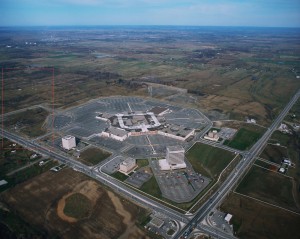
Figure 6: City Centre Crossroads, 1973. Another view of Square One. To the left is where the civic centre was going to be built.
Photographer: Ron Duquette, Courtesy of Heritage Mississauga
The downtown core of Mississauga was expanding, and under Mayor Hazel McCallion’s leadership several other landmarks were built including the Mississauga civic centre, which included the civic square, which is part of the present-day Celebration Square. The rest of the area where Celebration Square i nowHowever, remained empty in hopes of constructing another building in the future. This building never ended up getting built. McCallion knew that the underlying factor for a healthy city started from the social activities that would breathe life into the city. Therefore, the purpose of the civic square was to create a suburban locale to be used as a space for community events with a potential for energizing entertainment. The 1987 grand opening of the civic centre and square included a fireworks display, a visitation from the Duke and Duchess of York; Prince Andrew and Sarah Ferguson, as well as musical performances by The Nylons, Music Machine, and Wasted Knights (Calleja, 1987). Music Machine and Wasted Knights were local groups that specialized in ‘50s and ‘60s music, while The Nylons were founded in Toronto (see Figure 7).
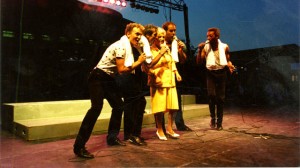
Figure 7: Hazel McCallion on stage with The Nylons, 1987
Courtesy of City of Mississauga photo collection/Peel Art Gallery, Museum and Archives.
The biggest performance on the main stage of civic square was undoubtedly during its 1987 grand opening. In the following years, the civic square was predominantly used during for holiday events where local performers such as the Mississauga Pops Concert Band and Justus entertained (MacDonald, 1997). The civic square was also overwhelmingly used for viewing exhibitions, and meeting local groups. Eventually over the years, it lost its luster and excitement.
The Celebration Square is a redevelopment of an empty space in the city centre and includes the original civic square. In January 2009, Mississauga announced its plans to redevelop its civic square and surrounding area (“Mississauga civic,” 2009). This project was intended to transform “an urban dead zone into a lively public space” (“Mississauga civic,” 2009). Not only did this space lack aesthetically pleasing visuals, but the infrastructure had also disintegrated. The area became known as dead space and contained trees in the middle that obstructed views and discouraged pedestrian traffic (see Figure 8). According to a local archive, this redevelopment was part of the Infrastructure Stimulus Program (ISF) which amounted to around $40 million (see Figure 9). This massive revitalization of the dead space, the civic square as well as the Central Library reconfirmed the importance of creating a large space that promoted cultural activities. This project also symbolized the crucial requirement for the involvement and interaction of Mississauga’s citizens. The project required making the city centre feel more pedestrian-friendly to encourage a flow of people. The city decided to reconstruct the area to make the space feel more open and inviting.
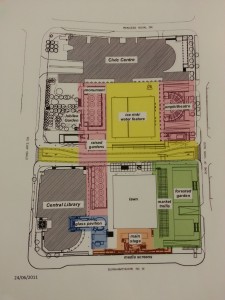
Figure 9: The architectural layout of the Celebration Square including the main stage at the bottom.
Courtesy of the Canadiana Room, Mississauga Central Library Archives
The result was the Celebration Square, which rose to popularity after its debut in the summer of 2011 (see Figure 10). In present-day, the Celebration Square is not only used for holidays and major events, but it is becoming more of a commonplace venue especially during the summer. It reflects the pedestrian lifestyle of an urban citizen in a suburban area. The Square is also committed to representing Canadian artists such as Shawn Desman (see Figure 11) and Carly Rae Jepsen who have successfully entered the mainstream music industry.
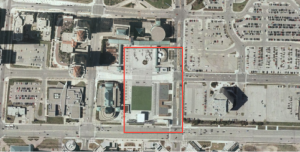
Figure 10: Aerial view of the Celebration Square, 2013. eMaps, Mississauga’s Interactive Online Mapping Service
Retrieved on November 27, 2013 on http://www.mississauga.ca/portal/services/maps.

Figure 11: A poster for a concert in 2011 including Shawn Desman
Courtesy of the Canadiana Room, Mississauga Central Library Archives
Contemporary Analysis of the Celebration Square
In this section, I will discuss the findings of the space in terms of my interpretation of the space as well as interview responses from individuals who visit the Celebration Square. It is also my objective to show how music contributes to the experience and use of the space.
Rather than studying music within a physical or biological context, R. Murray Schafer (1994) claims that a cultural approach is required to the study the relationship of people to music. However, this presents a difficulty since the focus in Western culture is on visual study instead of oral. At the Celebration Square, using visuals is a key form of entertainment is seen in the strategically placed large television screens and lighting fixtures (see Figure 12). The significance of the ocular rather than the oral is reaffirmed by Interviewee A, where she claims that, “I was mostly drawn to the vivid screen and sometimes I just focused on the way the band was performing, like their movements, especially when I didn’t like the song” (interview, November 20, 2013). This suggests that Western culture does not pay as much attention to sound as it does to images and representations. The participant’s comment confirms that seeing becomes a primary way of experiencing events at Celebration Square while hearing and listening become secondary.
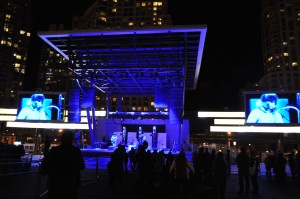
Figure 12: The main stage at the Celebration Square, November 2013, shows the two large television screens placed on either side of the stage.
Photographer: Zofia Karkowska, 2013
Schafer (1994) also claims that the “soundscape” is simply like a landscape instead the focus is on how sound contributes to the overall meaning of the space. Schafer further explains that there exists an original soundscape whereby natural sounds reveal real sounds of the area (Kelman, 2010). In terms of the Celebration Square where years of urbanization has taken place, Schafer would argue that the true soundscape has been inevitably ruined and infringed by “‘noise pollution,’ ‘sound sewers,’ ‘overpopulation’, and the encroachment of modern, mechanized life on the more pastoral sounds of countryside, sea and forest” (Kelman, 2010, p. 216). In other words, the technologies in the Celebration Square such as the lights, speakers, screens, and stage have destroyed the soundscape of the original farmland that was once there. Schafer would also argue that invitation to the area causes overpopulation and there is a need to control the noise in the Celebration Square. However, Schafer’s pessimistic account of noise and the emphasis on control would only eliminate the mandate of encouraging pedestrians at the Square.
The Celebration Square’s vast size also allows multiple acts to be performed simultaneously. One of my interviewees stated that she was at an event where there were multiple musical acts in different areas of the Square. For instance, she stated that there was a contemporary pop performance taking place on the main stage and a hip-hop event on the side. This particular event allowed the performers to structure the speakers in various locations in order to attract passerby from one attraction to the next. Interviewee A remembered that the hip-hop station attracted many youth but what was striking to her was that a youth basketball team remained affixed to the station for a significant amount of time. Although I am only making an inference, this comment suggests that certain music genres attract certain people and hence a connection is established within a specific context. This is parallel to Jonathan Sterne’s argument whereby Sterne utilizes Stuart Hall’s idea whereby music is always involved in “articulation” as “the process through which otherwise independent meanings, ideologies, or people are unified in some sense” (Sterne, 1997, p. 40). Although, articulation is not a natural process (Sterne, 1997), the various music stations produce meaning by attracting different types of people to establish the link between music and certain characteristics to develop an ideology that get repeated as commonplace. In this case, hip-hop music and basketball are unified as a wholesome meaning.
It is also worthwhile to analyze the way the space is designed in terms of its size. The openness of the Celebration Square reflects the idea of the ability to move within the space (see Figure 13). Even though the Square is an open space, it does not mean that people are not controlled by the sound and music in the space. Sterne (1997), in his essay on the mall design, claims that music and sound are instrumental in managing space. In this case, I needed to look at how the music actually affects one’s physical being in the space. This became clear when Interviewee B elaborated about her experience at a Canada Day concert which included Carly Rae Jepsen as one of the main performers. She stated, “I noticed that those who were true fans were all the way at the front of the stage. Others, in particular, teenage boys moved all the way to the back as soon as Jepsen started singing. They pretended like they were in their own world and it seemed like they were not interested in the performer (Interviewee B, interview, November 22, 2013). This comment reflects how sounds contribute to the control of individuals. This is also reflected in Hirsch’s (2007) essay whereby classical music was used as a crime prevention strategy. Overall, the interesting idea in Hirschi’s analysis is that “teens do not change their ways or become more ethical through the magical power of classical music; rather they take their activities elsewhere” (Hirsch, 2007, p. 348). Ultimately, music at the Square serves to control and situate certain people in specific locations of the space. This includes the ability to disassociate oneself from a particular performer or genre by using the body as an action.
Figure 13: A video sample of the Celebration Square and its openness.
Music in this space presents another idea of physical embodiment through auditory latching. Brandon LaBelle (2008) argues that people sometimes engage in a process of “auditory latching” whereby human interaction and sound merge as a unified action. Auditory latching can be argued as creating a sense of security. However, in the context of the Celebration Square, auditory latching works as confirming one’s existence in the space. One shows the effect of music by clapping, tapping, moving their bodies, etc. Both interviewees confirmed that there is always a physical reaction to the music around them and there is a need to express their existence among the crowd by moving or making personal noise to the beat of the music.
What is interesting about the space is where the main stage is located. The stage faces the civic centre instead of the condominiums. It is purposely designed in this way in order to reduce the amount of noise complaints from nearby residents. The square is also a pedestrian-friendly place primarily because it does not have a lot of furniture; rather, it is a smooth, open area. It offers picnic tables in the summer and also contains artificial grass which represents a real outdoor concert. The artificial grass encourages people to relax and lounge around, to bring their own chairs, or to have picnics in the summer. The space offers endless possibilities and its versatility is what attracts the people of Mississauga. Since the space is not restricted by furniture, it works to encourage to make the space one’s own.
The Celebration Square also serves the purpose of bringing a community together to socialize and interact. The use of music in the creation of a place is undoubtedly reflected in Sara Cohen’s (1998) essay where she claims that “the consumption and production of music also draws people together and symbolized their sense of collectivity and place” (p. 273). This is evident especially in the prominence of cultural events that always involve music as integral to cultural production within Mississauga. Coming from a public school, Interviewee A stated that many of her Middle Eastern friends and families attended Bollywood and Muslim events at the Square. The popularity of these events “illustrate music’s role in the social production of that neighbourhood” (Cohen, 1998, p. 276). Since Mississauga is composed of diverse ethnic backgrounds, these events provide a distinct spotlight on certain nationalities. Music is a tangible experience of traditions and has an ability to bring back memories and stir emotions in its listeners.
Both interviewees stated that the area always contains a mixture of adults, children, families, and teenagers that created a lively space. Interviewee A spoke about the interaction in the space where she said, “I look forward to attending these concerts because I always find myself bumping into friends or seeing old friends. I feel like it is sort of like an unwritten rule for people to attend. Plus, being at the Celebration Square shows that you are proud of being in your city especially when you hear local music play” (interview, November 20, 2013). Interviewee B also said, “I feel like I am a part of the celebration when I dance or sing during a concert. I can always count on the Square for creating a musical event for any occasion and this is important because I no longer have to travel to the crowded Nathan Philips Square in Toronto to come out and celebrate (interview, November 22, 2013). The interviewees also stated experiences that were congruent to Cohen’s analysis of Jack Levy where “the physical pleasures of music and the way in which it resonates with the body, stimulating movement and emotion, emphasize the intensity of experience evoked by music and its effectiveness in producing a sense of identity and belonging” (Cohen, 1998, p. 277). Music at the Square is a physical experience that is also revealed in the marketing of the place as seen in the following advertisement (see Figure 14). The Celebration Square and its local place within the city produces an emotional reaction with the participants to the point where the participants found that they would be betraying the Square, along with the music, if they did not attend the concerts at the Celebration Square.

Figure 14: Pamphlet for the opening of the Celebration Square
Courtesy of the Canadiana Room, Mississauga Central Library Archives
Closing Remarks
In the course of completing this assignment, I found many critical links to the way music is experienced in this space. I also think that because of the openness and uniqueness of the space, the Celebration Square definitely offers a sense of community and belonging that some venues lack. Although the space is relatively new, it nevertheless offers many events that continually enhance the importance of music and entertainment in the city. Music in this space serves as a physical experience, contributes greatly to the creation of an interactive atmosphere, and shapes the types of activities that occur at the Celebration Square.
Bibliography
Aerial Photography. eMaps, Mississauga’s Interactive Online Mapping Service. Retrieved on November 27, 2013 on http://www.mississauga.ca/portal/services/maps.
Calleja, F. T. S. (1987, July 14). Spectacular fireworks, nylons show colorful finale to Mississauga party. Toronto Star. Retrieved from http://www.lexisnexis.com.ezproxy.library.yorku.ca/
Carr Farm (Photograph). (1963) Retrieved November 27, 2013 from www.mississauga.ca, identifier: F922.
Chin, J. (2010, October 4). Celebration Square on home stretch. Mississauga.com. Retrieved from www.mississauga.com
Duquette, R. (Photographer). (1973). City Centre Crossroads [photograph]. (1973). Heritage Mississauga.
Hazel McCallion on stage with The Nylons (Photograph). (1987). City of Mississauga photo collection, Mississauga, Peel Art Gallery, Museum and Archives, accession number 2004.051, file 31.
Cohen, S. (1998). Sounding Out the City: Music and the Sensuous Production of Place. In A. Leyshon, D. Matless, and G. Revill (Eds.), The Place of Music (pp. 434-446). New York: The Guilford Press.
Hicks, K. A. (2005). Cooksville: Country to City. Mississauga: The Friends of the Mississauga Library System.
Hirsch, L. (2007). Weaponizing Classical Music: Crime Prevention and Symbolic Power in the Age of Repetition. Journal of Popular Music Studies, 19(4), 342-358.
Karkowska, Z. (Photographer). (2013). A poster for a concert in 2011. Courtesy of the Canadiana Room, Mississauga Central Library Archives.
Karkowska, Z. (Photographer). (2013). Architectural layout of the Celebration Square. Courtesy of the Canadiana Room, Mississauga Central Library Archives.
Karkowska, Z .(Photographer). (2013). Pamphlet for the opening of the Celebration Square
Courtesy of the Canadiana Room, Mississauga Central Library Archives.
Karkowska, Z. (Photographer). (2013). The main stage at the Celebration Square.
Karkowska, Z. (Producer). (2013). Video sample of the Celebration Square and its openness. Available from http://popmusic.info.yorku.ca/files/2013/11/sample.mov
Kelman A.Y. (2010). Rethinking the Soundscape: A Critical Genealogy of a Key Term in Sounds Studies. The Senses and Society, 5(2), 212 -234.
MacDonald, Cindy. (1997, June 26). Celebrate holiday at Civic Centre. Toronto Star. Retrieved from http://www.lexisnexis.com.ezproxy.library.yorku.ca/
Mayor plants time capsule in new civic centre site. (1970, June 30). Mississauga Times: Serving Mississauga, Port Credit, and Streetsville. Retrieved from http://search.canadiana.ca
McLaughlin Makes New Offer: Town Hall Fire May Lead to City Centre. (1969, June 18). The South Peel Weekly. Retrieved from http://search.canadiana.ca
Mississauga civic square. (2009, January 27). Toronto Star. Retrieved from http://www.lexisnexis.com.ezproxy.library.yorku.ca
Pope. J. H. (1877). Illustrated Historical Atlas of the County of Peel, Ont. Toronto: Walker & Miles.
Schafer, R. M. (1994). The Soundscape. Rochester: Alfred Knopf, Inc.
Sterne, J. (1997). Sounds like the Mall of America: Programmed Music and the Architectonics of Commercial Space. Ethnomusicology, 41(1), 22-50.
Urbaniak, T. (2009). Her Worship: Hazel McCallion and the Development of Mississauga. Toronto: University of Toronto Press Inc.
